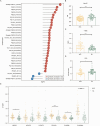Impaired Membrane Lipid Homeostasis in Schizophrenia
- PMID: 35751100
- PMCID: PMC9434453
- DOI: 10.1093/schbul/sbac011
Impaired Membrane Lipid Homeostasis in Schizophrenia
Abstract
Background and hypothesis: Multiple lines of clinical, biochemical, and genetic evidence suggest that disturbances of membrane lipids and their metabolism are probably involved in the etiology of schizophrenia (SCZ). Lipids in the membrane are essential to neural development and brain function, however, their role in SCZ remains largely unexplored.
Study design: Here we investigated the lipidome of the erythrocyte membrane of 80 patients with SCZ and 40 healthy controls using ultra-performance liquid chromatography-mass spectrometry. Based on the membrane lipids profiling, we explored the potential mechanism of membrane phospholipids metabolism.
Study results: By comparing 812 quantified lipids, we found that in SCZ, membrane phosphatidylcholines and phosphatidylethanolamines, especially the plasmalogen, were significantly decreased. In addition, the total polyunsaturated fatty acids (PUFAs) in the membrane of SCZ were significantly reduced, resulting in a decrease in membrane fluidity. The accumulation of membrane oxidized lipids and the level of peripheral lipid peroxides increased, suggesting an elevated level of oxidative stress in SCZ. Further study of membrane-phospholipid-remodeling genes showed that activation of PLA2s and LPCATs expression in patients, supporting the imbalance of unsaturated and saturated fatty acyl remodeling in phospholipids of SCZ patients.
Conclusions: Our results suggest that the mechanism of impaired membrane lipid homeostasis is related to the activated phospholipid remodeling caused by excessive oxidative stress in SCZ. Disordered membrane lipids found in this study may reflect the membrane dysfunction in the central nervous system and impact neurotransmitter transmission in patients with SCZ, providing new evidence for the membrane lipids hypothesis of SCZ.
Keywords: lipidome; membrane fatty acids; membrane lipids; oxidative stress; phospholipid remodeling; schizophrenia.
© The Author(s) 2022. Published by Oxford University Press on behalf of the Maryland Psychiatric Research Center. All rights reserved. For permissions, please email: journals.permissions@oup.com.
Figures





Similar articles
-
Characterising phospholipids and free fatty acids in patients with schizophrenia: A case-control study.World J Biol Psychiatry. 2021 Mar;22(3):161-174. doi: 10.1080/15622975.2020.1769188. Epub 2020 Jul 17. World J Biol Psychiatry. 2021. PMID: 32677491
-
Metabolic profiling identifies phospholipids as potential serum biomarkers for schizophrenia.Psychiatry Res. 2019 Feb;272:18-29. doi: 10.1016/j.psychres.2018.12.008. Epub 2018 Dec 7. Psychiatry Res. 2019. PMID: 30579177
-
Membrane lipidomics in schizophrenia patients: a correlational study with clinical and cognitive manifestations.Transl Psychiatry. 2016 Oct 4;6(10):e906. doi: 10.1038/tp.2016.142. Transl Psychiatry. 2016. PMID: 27701405 Free PMC article.
-
Phospholipid membrane abnormalities and reduced niacin skin flush response in schizophrenia.Psychiatr Danub. 2008 Sep;20(3):372-83. Psychiatr Danub. 2008. PMID: 18827766 Review.
-
Membrane phospholipids and cytokine interaction in schizophrenia.Int Rev Neurobiol. 2004;59:297-326. doi: 10.1016/S0074-7742(04)59012-8. Int Rev Neurobiol. 2004. PMID: 15006493 Review.
Cited by
-
Apolipoprotein D as a Potential Biomarker in Neuropsychiatric Disorders.Int J Mol Sci. 2023 Oct 26;24(21):15631. doi: 10.3390/ijms242115631. Int J Mol Sci. 2023. PMID: 37958618 Free PMC article. Review.
-
Plasma Metabolic and Inflammatory Protein Signatures in Psychiatric Disorders.Int J Mol Sci. 2025 Jun 28;26(13):6260. doi: 10.3390/ijms26136260. Int J Mol Sci. 2025. PMID: 40650038 Free PMC article.
-
LC-HRMS Lipidomic Fingerprints in Serbian Cohort of Schizophrenia Patients.Int J Mol Sci. 2024 Sep 24;25(19):10266. doi: 10.3390/ijms251910266. Int J Mol Sci. 2024. PMID: 39408605 Free PMC article.
-
An integrative multi-context Mendelian randomization method for identifying risk genes across human tissues.Am J Hum Genet. 2024 Aug 8;111(8):1736-1749. doi: 10.1016/j.ajhg.2024.06.012. Epub 2024 Jul 24. Am J Hum Genet. 2024. PMID: 39053459 Free PMC article.
-
Molecular genetics of neuropsychiatric illness: some musings.Front Genet. 2023 Nov 1;14:1203017. doi: 10.3389/fgene.2023.1203017. eCollection 2023. Front Genet. 2023. PMID: 38028602 Free PMC article.
References
-
- Marder SR, Cannon TD. Schizophrenia. N Engl J Med. 2019;381(18):181753–1761. - PubMed
-
- Olney JW, Farber NB. Glutamate receptor dysfunction and schizophrenia. Arch Gen Psychiatry. 1995;52(12):998–1007. - PubMed
-
- Gattaz WF, Kollisch M, Thuren T, Virtanen JA, Kinnunen PK. Increased plasma phospholipase-A2 activity in schizophrenic patients: reduction after neuroleptic therapy. Biol Psychiatry. 1987;22(4):421–426. - PubMed
Publication types
MeSH terms
Substances
LinkOut - more resources
Full Text Sources
Medical

